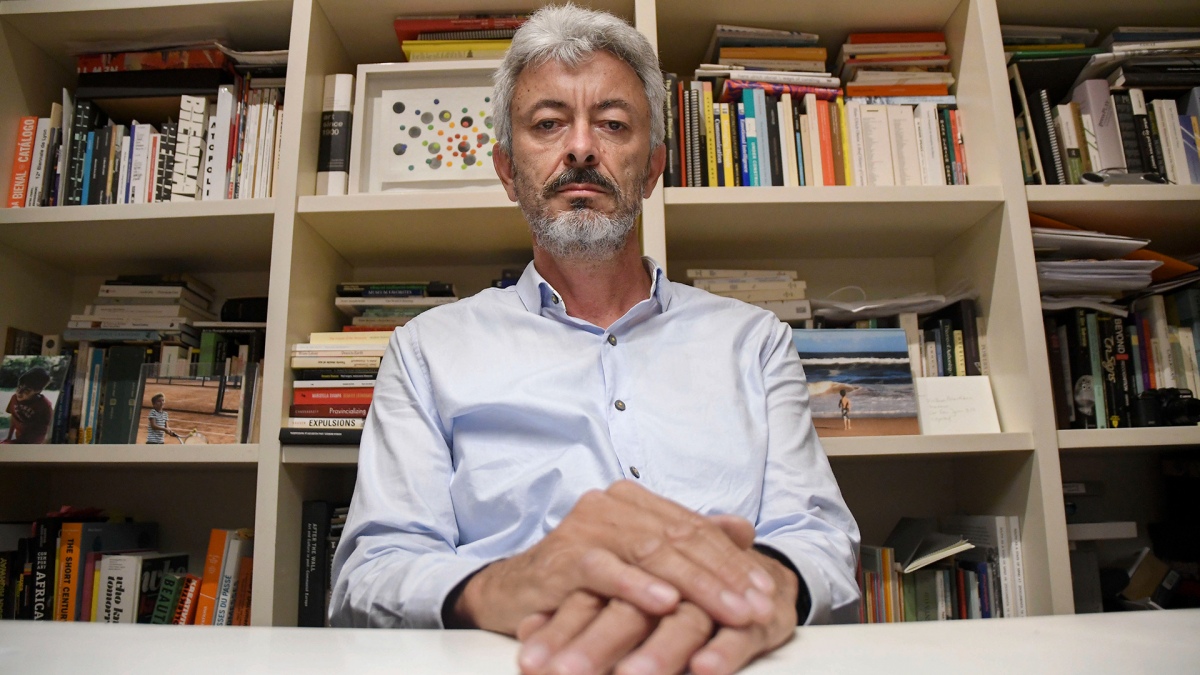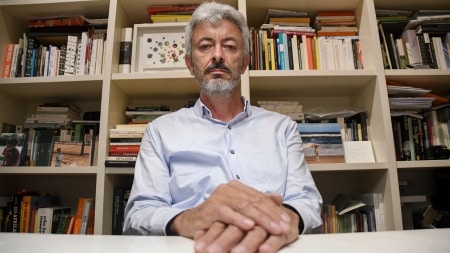 He was interested in exploring Gamerro is how the experience of going through a pandemic changes us not only as a society but as people / Photo: Raúl Ferrari
He was interested in exploring Gamerro is how the experience of going through a pandemic changes us not only as a society but as people / Photo: Raúl Ferrari
The new book by the writer and critic Carlos Gamerro, “Seven essays on the plague”, recalls the best genealogy of the genre in Argentina, without going any further from the title to Borges’ “Seven nights”, a tradition from the River Plate that the author of “La cage de los onas” and “Facundo o Martín Fierro” honors with leftovers from the journey of epidemics and pandemics in literature and the arts, from Homer’s “Iliad” to the “Walking dead” series, for question contemporary experience.
Based on the book published by Taurus, Gamerro explains that the literature on the plague can have a “let’s say, practical” function (what precautions to take, how to react to the illness of a loved one, what sanitary regulations to follow) which is what may seem more important in times of epidemic and another “that we could call existential: the plague has always been with us, has accompanied, and contributed to shaping all human societies and associations.”
“It is an experience, a living, a nightmare that defines the human condition, as much as war, migration, sex, birth and death,” explains the writer born in 1962 in Buenos Aires. One of the aspects that Gamerro was interested in exploring is how the experience of going through a pandemic changes us not only as a society but as people: “these are irreversible changes even if we don’t realize it, and the first reaction, after the epidemic is over, or At least when its most extreme terrors have subsided, it is to forget it, to return to the life of before: a natural, understandable longing, manifested by the characters of Defoe, Saramago, Camus… but doomed to failure, or self-deception”, explains the writer to Télam and adds: “After an epidemic we are different, forever. Reading this literature helps us to accept it, and to try to understand what we have become.”
-Télam: What is the trigger that the plague has to gather stories, write novels or essays around the subject?
-Carlos Gamerro: Until about a hundred years ago, the end of epidemics was believed to have come, and humanity, especially in the developed world, for that reason forgot what they could do to us, and neglected to foresee them. And so what we are experiencing took us by surprise: I am not just talking about science, or governments, but about each one of us: most catastrophes, whether natural, such as floods, earthquakes or storms, are man-made like famine, forced displacement and war, they tend to unite families, groups, and nations. The epidemic, on the other hand, is a great solvent of social ties: other people are factories of viruses, of contagion, of death: my fellow man is my enemy.
-T.: Is that what appears in fiction?
-CG: I was getting to that point: movies about zombies and the living dead metaphorize these fantasies: if my brother, my mother, my son, are bitten and become, I not only have the right, but also the duty to kill them before they keep spreading evil. Thus, the epidemic feeds two opposite and symmetrical paranoid fantasies, which in my book I call the Hobbesian and the Orwellian, respectively. In the first, the plague produces a civilizational collapse: it is every man for himself, governments collapse, social ties dissolve, humanity reverts to a state of primitive barbarism. It is the script for any self-respecting living dead movie, and its first literary manifestation is perhaps the novel “The Scarlet Plague” by Jack London. This idea of a ‘reversion’ to tribalism is pure myth: as London’s novel makes clear, the free-for-all state has less to do with primitive savagery than with modern capitalism.
In the second, governments take advantage of the epidemic, or directly invent it, to establish a totalitarian regime, a meticulous and perfect surveillance society. It is, as I pointed out, fantasies: none of that happens in novels that, like those of Defoe and Camus, try to recreate the way in which plagues have actually happened in history. But paranoid fantasies, conspiracy theories, wild imaginations, irrational panic, are as much an integral part of the epidemic as viruses, the medical system, and death; and the works that explore this aspect of the epidemic are just as important and instructive.
-T.: And did reading literature on the subject awaken in you that passion?
-CG: Western literature begins with an epidemic: the one that falls on the Greek camp in Book I of “The Iliad”, and is the indirect cause of the dispute between Agamemnon and Achilles; also with an epidemic the action of “Oedipus the King” begins, since it is this that triggers the fateful search for Oedipus; Sparta’s victory in the Peloponnesian War was largely due to the epidemic that devastated Athens, ending, among others, the life of Pericles, as we read in “The History of the Peloponnesian War” by Thucydides, the first story historical account of the effects of an epidemic, and a model for those to follow, including Lucretius’s philosophical poem, “De rerum natura”. There will be works in which the plague is just an episode that interrupts the course of other activities, such as war, in the work of Thucydides; in others, the epidemic brings unexpected benefits, enabling forbidden desires and repressed behaviors, as in the “Decameron”, in “Death in Venice”, in “Love in the Time of Cholera”; Novels such as Daniel Defoe’s “Plague Year Diary” or Camus’ “La Plague” deserve special mention, since they completely adhere to the history of the epidemic, narrating how the life of the entire community: because unlike the mere disease, the epidemic is always – although the story sometimes focuses on a few individuals – a collective experience.
-T.: How did the theme of pests mark Argentine literature?
-CG: In Argentine literature the brand has not been very strong up to now, surely this will change with the current pandemic, whose literature is being written at this moment. The yellow fever of 1871 did not leave a great mark on our literature, not much more than a mention in the poem “Muertes de Buenos Aires” by Borges; and the great influenza pandemic, poorly known as the Spanish flu, even less so. It’s a shame: in the absence of an oral tradition, of a collective memory, literature could have helped us to be better prepared to understand what began to happen to us in 2020. There are stories, snippets of stories, of the epidemics that decimated the our native peoples, such as the black smallpox that hits the tolderías in “La vuelta de Martín Fierro” and causes the death of Cruz (and also, indirectly, of the captive gringuito that the Indians drown “in a puddle, because of the plague”). But Fierro is more happy than sad about the matter: he thinks it’s good that the Indians die like flies, and he only regrets that they passed it on to Cruz before doing so.
In “An Excursion to the Ranquel Indians” by Lucio V. Mansilla it is also narrated how the scourge of the plague falls on the Indians, but this time with a humanitarian and compassionate look. The germs and viruses that the whites brought from Europe did most of the dirty work: without them the conquest would have been much harder, and slower.
In literature, the plague can also function as an ally of conquest: in Ray Bradbury’s “Martian Chronicles”, chickenpox annihilates the Martians after the arrival of humans on Mars; although in the previous “War of the Worlds” by HG Wells it is the other way around: the Martians invade the Earth and they are exterminating us with great ease, harvesting us like vegetables, until terrestrial bacteria finish them off. In the conquest of America there was at least one similar episode: yellow fever killed the more than sixty thousand men that Napoleon sent to Haiti to put down the rebellion of the blacks and reinstate slavery on the island: events that also left their mark on literature, notably in two great novels by Alejo Carpentier, “The kingdom of this world” and “The century of lights”.
-T.: How do you locate the different “plagues” in your book?
CG: In this book I focus not only on how the experience of the plague is lived, but also how it is told, and how it is explained to those who did not experience it. In one of the chapters, entitled “The style of the plague”, I contrast, for example, the romantic exaltation, full of apostrophes, exclamations, mythological allusions and sublime elevations of, for example, Mary Shelley in “The Last Man”, an extensive novel about an imaginary epidemic that ends humanity, with the journalistic, flat, informative style of Daniel Defoe. Camus characterizes the style of the plague as ‘meticulous and dull’ in his novel, but in his later play “The State of Siege”, which tells how a personified plague ends up ruling an entire town until people stop believing it and he rebels against it, he lets himself be carried away by the lyrical-poetic impulse and the result is pathetic. It is also very important to take into account whether the work in question is talking about the plague itself, or as a metaphor for any other evil: “The plague” and “Essay on blindness” by Saramago are carried away by allegorical temptation: the plague that falls on Oran is a metaphor for war and occupation, and in Saramago’s novel the blindness that infects the entire population is that of our inhumanity, selfishness, or that of the capitalist system, etc. etc. In Defoe’s novel, on the other hand, the plague is nothing other than the plague. That is perhaps why it is the most interesting, the most honest and true of all those written on the subject.


